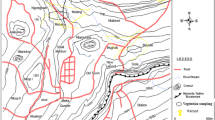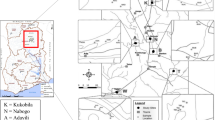Abstract
In this research, Juncus acutus and Salicornia perennans communities which have different floristic composition and are developing on soils with different salinity degree in Yeşilırmak Delta were investigated. The phytosociological properties of the communities were analyzed by Braun–Blanquet method. The effect of edaphic parameters on the communities was determined using ordination techniques (CCA). Galatello pannonicae–Juncetum acuti ass. nov. develops on soils with high EC, while Samolo valerandi–Juncetum acuti Korkmaz et al. Ekoloji 21:64–79, 2012 and Spergulario marinae–Salicornietum perennantis ass. nov. develop on soils which have relatively low EC value. Consequently, the edaphic factors showing variation depending on microtopography have affected the plant community distribution in Yeşilırmak coastal wetland sites.


Similar content being viewed by others
Data availability
Not applicable.
Code availability
ECOM 2.1.3.137 software programme for canonical correspondence analysis (CCA).
References
Asri Y, Ghorbanli M (1997) The halophilous vegetation of the Orumieh Lake Salt Marshes, NW Iran. Plant Ecol 132:155–170
Berg M, Joyce C, Burnside N (2012) Differential responses of abandoned wet grassland plant communities to reinstated cutting management. Hydrobiologia 692:83–97. https://doi.org/10.1007/s10750-011-0826-x
Bergfur J, Carlsson ALM, Milberg P (2004) Phenological changes within a growth season in two semi-natural pastures in southern Sweden. Ann Bot Fennici 41:15–25
Bergmeier E, Schaminée JHJ (2016) Classifying halophytes and halophytic vegetation – an editorial. Phytocoenologia 46(4):333–338. https://doi.org/10.1127/phyto/2016/0174
Bertacchi A, Lombardi T, Saggese A, Lazzeri V (2021) The vegetation of a relict salt marsh area in the Pisan coast in the context of brackish wetlands of Tuscany. Plant Sociology 58(1):41–53. https://doi.org/10.3897/pls2021581/03
Biondi E, Casavecchia S (2010) The halophilous retro-dune grasslands of the Italian adriatic coastline. Braun-Blanquetia 46:11–127
Biondi E, Blasi C, Allegrezza M, Anzellotti I, Azzella MM, Carli E, Casavecchia S, Copiz R, Del Vico E, Facioni L, Galdenzi D, Gasparri R, Lasen C, Pesaresi S, Poldini L, Sburlino G, Taffetani F, Vagge I, Zitti S, Zivkovic L (2014) Plant communities of Italy: the vegetation prodrome, plant biosystems - an international journal dealing with all aspects of. Plant Biol 148(4):728–814. https://doi.org/10.1080/11263504.2014.948527
Boscaiu M, Ballesteros G, Naranjo MA, Vicente O, Boira H (2011) Responses to salt stres in Juncus acutus and J. maritimus during seed germination and vegetative plant growth. Plant Biosystems 145(4):770–777. https://doi.org/10.1080/11263504.2011.628446
Braun-Blanquet J (1964) Pflanzensoziologie-Grundzüge der Vegetationskunde. Springer Verlag, Wien and New York
Braun-Blanquet J, de Bolòs O (1957) Les groupements végétaux du bassin moyen Del l’Ebre et leur dynamisme. Anales De La Estación Experimental De Aula Dei 5:1–266
Demiralay İ (1993) Toprak Fiziksel Analizleri. Atatürk Üniversitesi Ziraat Fakültesi Yayınları, 143, Erzurum.
Dengler J, Chytrý M, Ewald J (2008) Phytosociology. In Jorgensen SE, Fath BD: Encyclopedia of Ecology, Vol. 4 - General Ecology. Elsevier, Oxford: 2767–2779
Diamond JS, Epstein JM, Cohen MJ, McLaughlin DL, Hsueh YH, Keim RF, Duberstein JA (2021) A little relief: Ecological functions and autogenesis of wetland microtopography. Wires Water. https://doi.org/10.1002/wat2.1493
Dítĕ D, Šuvada R, Dítĕ Z (2021) Habitat shaped by ancient salt: vegetation of the classes Therosalicornietea and Festuco-Puccinellietea in the transylvanian basin (Romania). Folia Geobot 56(2):109–123
Davis PH (ed) (1965–1985) Flora of Turkey and the East Aegean Islands, Vol. 1–9, Edinburgh Univ. Press, Edinburgh.
Freitag H, Golub VB, Yuritsyna NA (2001) Halophytic plant communities in the northern Caspian lowlands: 1, annual halophytic communities. Phytocoenologia 31(1):63–108
Frondoni R, Iberite M (2002) The halophile vegetation of the sedimentary coast of Lazio (central Tyrrhenian district, Italy). Plant Biosys Inter J Dealing with Aspects Plant Bio 136(1):49–67. https://doi.org/10.1080/11263500212331358521
García-Madrid AS, Rodríguez-Rojo MP, Cantó P, Molina JA (2016) Diversity and classification of tall humid herb grasslands (Molinio-Holoschoenion) in Western mediterranean Europe. Appl Veg Sci 19:736–749
González MB (2019) Adaptation of halophytes to different habitats. InthechOpen Access. https://doi.org/10.5772/intechopen.87056
Görmüş T, Ayat B, Aydoğan B, Tătui F (2021) Basin scale spatiotemporal analysis of shoreline change in the Black Sea. Estuar Coast Shelf Sci. https://doi.org/10.1016/j.ecss.2021.107247
Grechushkina NA, Sorokin AN, Golub VB (2010) Plant communities of the Thero-Salicornietea and Salicornietea fruticosae classes along the Russian coast of the Sea of Azov. Chornomors’k Bot Z 6(2):200–212
Guarino R, Willner W, Pignatti S, Attorre F, Loidi J (2018) Spatiotemporal variations in the application of the Braun-Blanquet approach in Europe. Phytocoenologia 48(2):239–250. https://doi.org/10.1127/phyto/2017/0181
Herrera M (1995) Estudio de la vegetación y flora vascular de la Cuenca del Río Asón (Cantabria). Guineana 1:1–435
Imeri A, Mullaj A, Dodona E, Kupe L (2010) Costal vegetation of the Lalzi bay (Albania). Botanica Serbica 34(2):99–105
Janssen JAM, Rodwell JS, García Criado M et al (2016) European Red List Habitats. Part 2:Terrestrial and freshwater habitats. European Commission, Brussels, BE. https://doi.org/10.2779/091372
Kacar B (2009) Toprak Analizleri, 2. Baskı, Nobel Yayın Dağıtım, Ankara
Kacar B (1994) Bitki ve toprağın kimyasal analizleri: III. Toprak Analizleri, Ankara Üniversitesi Ziraat Fakültesi Eğitim Araştırma ve Geliştirme Vakfı Yayınları, No:3, Ankara.
Karaömerlioğlu D (2007) Göksu Deltasındaki (Silifke) Doğal Ekosistemlerin Bitki Ekolojisi Yönünden Araştırılması. Doktora Tezi, Çukurova Üniversitesi, Fen Bilimleri Enstitüsü, Adana
Ketenoğlu AO, Tuğ GN, Bingöl Ü, Geven F, Kurt L et al (2010) Synopsis of syntaxonomy of Turkish forests. J Environ Biol 31(1):71–80
Korkmaz H, Mumcu Ü, Alkan S, Kutbay HG (2012) Gölardı (Terme/Samsun)Yaban Hayatı Koruma Alanı’nın psammofil, higrofil ve orman vejetasyonu üzerine sintaksonomik bir araştırma. Ekoloji 21(85):64–79. https://doi.org/10.5053/ekoloji.2012.858
Korolyuk AY, Anenkhonov OA, Chepinoga VV, Naidanov BB (2017) Communities of annual halophytes (Thero-Salicornietea) in Transbaikalia (Eastern Sibiria). Phytocoenologia 47(1):33–48. https://doi.org/10.1127/phyto/2017/0143
Lefeuvre JC, Laffaille P, Feunteun E, Bouchard V, Radureau A (2003) Biodiversity in salt marshes: from patrimonial value to ecosystem functioning the case study of the Mont- Saint-Michel bay. CR Biol 326(1):125–131. https://doi.org/10.1016/S1631-0691(03)00049-0
Liu Y, Li G, Wang M, Ma C, De Boeck HJ, Hou F, Li Z (2022) Effects of water supply on plant stoichiometry of C, N, P in inner Mongolia grasslands. Plant Soil. https://doi.org/10.1007/s11104-022-05467-5
van der Maarel E (2005) Vegetation Ecology. Blackwell Science Ltd, 395, Oxford, UK.
Mahdavi S, Salehi B, Granger J, Amani M, Brisco B, Huang W (2018) Remote sensing for wetland classification: a comprehensive review. Giscience Remote Sensing 55(5):623–658. https://doi.org/10.1080/15481603.2017.1419602
Moor H, Rydin H, Hylander K, Nilsson M, Lindborg R, Norberg J (2017) Towards a trait-based ecology of wetland vegetation. J Ecol 105(6):1623–1635. https://doi.org/10.1111/1365-2745.12734
Mucina L, Bültmann H, Dierßen K, Theurillat JP, et al (2016) Vegetation of Europe: hierarchical floristic classification system of vascular plant, bryophyte, lichen, and algal communities. Applied Vegetation Science 19(Supp 1):3-264 : https://doi.org/10.1111/avsc.12257
Mueller-Dombois D, Ellenberg H (2002) Aims and Methods of Vegetation Ecology. The Blackburn Press, Caldwell, New Jersey
Mumcu Ü, Korkmaz H (2018) Vascular flora of the central and western part of Yeşilırmak delta (Çarşamba/Samsun/Turkey). Phytologia Balcanica 24(1):87–98
Pandža M, Franjić J, Škvorc Ž (2007) The salt marsh vegetation on the East Adriatic coast. Biologia 62(1):24–31. https://doi.org/10.2478/s11756-007-0003-x
Rivas-Martínez S, Diaz T E, Gonzalez F F, Izco J, Lousa M and Penas A (2002). Vascular plant communities of Spain and Portugal. Adenda to the syntaxonomical checklist of 2001. Itinera Geobotanica, 15 (1–2): 5–922.
Sağlam MT (1997) Toprak ve Suyun Kimyasal Analiz Yöntemleri. 2. Baskı, Trakya Üniversitesi Ziraat Fakültesi Yayın No: 189, Ders Kitabı, No: 5, Tekirdağ.
Şahin K, Bağcı HR (2016) CBS ve UA teknikleriyle Türkiye’nin başlıca deltalarının morfometrik özelliklerinin değerlendirilmesi. Uluslararası Sosyal Araştırmalar Dergisi 9(42):984–990
Sciandrello S, Guglielmo A, Spampinato G (2014) Spatial patterns and floristic composition of plant communities in coastal salt marshes of south-eastern Sicily (Italy). Acta Botanica Gallica 161(2):99–109. https://doi.org/10.1080/12538078.2014.892026
Sciandrello S, Musarella CM, Puglisi M, Spampinato G, Tomaselli V, Minissale P (2019) Updated and new insights on the coastal halophilous vegetation of southeastern Sicily (Italy). Plant Sociology 56(2):81–98. https://doi.org/10.7338/pls2019562/06
Scott DB, Frail-Gauthier J, Mudie PJ (2014) Coastal wetlands of the world: geology, ecology, distribution and applications. Cambridge University Press, New York. https://doi.org/10.1017/CBO9781107296916
Seaby RMH, Henderson PA (2007) Environmental community analysis version 2.1.3.137. Pisces Conservation LTD. IRC House, The Square, Pennington, Lymington Hampshire, SO41 8GN, UK
Seminara G, Lanzoni S, Cecconi G (2011) Coastal wetlands at risk: learning from Venice and New Orleans. Ecohydrol Hydrobiol 11(3–4):183–202. https://doi.org/10.2478/v10104-011-0040-5
Sieben EJJ (2019) Zonal and azonal vegetation revisited: How is wetland vegetation distributed across different zonobiomes. Austral Ecol 44(3):449–460. https://doi.org/10.1111/aec.12679
Singh JS, Yadava PS (1974) Seasonal variation in composition, plant biomass, and net primary productivity of a tropical grassland at Kurukshetra, India. Ecological Monograph 44:351–376
Sørensen T (1948) A method of establishing groups of equivalent amplitude in plant sociology based on the similarity of species contents and its application to analysis of the vegetation of Danish Commons. Biologiske Skrifter Kongelige Danske Videnskabernes Selskab 5:1–34
Tambroni N, Lanzoni S, Seminara G (2022) Eco-morphodynamics of coastal wetlands. Rend Fis Acc Lincei 33:217–243. https://doi.org/10.1007/s12210-022-01070-z
Theurillat JP, Willner W, Fernández-González F, Bültmann H, Ćarni A, Gigante D, Mucina L, Weber H (2020) International Code of Phytosociological Nomenclature. 4th edition. Applied Vegetation Science, Report.
Tomaselli V, Veronico G, Sciandrello S, Forte L (2020) Therophytic halophilous vegetation classification in South-Eastern Italy. Phytocoenologia 50(2):187–209. https://doi.org/10.1127/phyto/2020/0364
Tüzüner A (1990) Toprak ve Su Analiz Laboratuvarları El Kitabı. T.C. Tarım ve Köy İşleri Bakanlığı, Köy Hizmetleri Genel Müdürlüğü, Ankara.
Tzonev R, Lysenko T, Gussev C, Zhelev P (2008) The halophytic vegetation in south-east Bulgaria and along the Black Sea coast. Hacquetia 7(2):95–121. https://doi.org/10.2478/v10028-008-0006-3
URL1. https://bolge11.tarimorman.gov.tr Accessed 30.05.2022
URL2. www.worldfloraonline.org Accessed 30.05.2022
URL3. https://www.eea.europa.eu/data-and-maps/data/eunis-habitat-classification-1. Accessed 11.05.2022
Vymazalová M, Tichý L, Axmanová I (2014) How does vegetation sampling in different parts of growing season influence classification results and analyses of beta diversity? Appl Veg Sci 17(3):556–566. https://doi.org/10.1111/avsc.12087
Ward RD, Burnside NG, Joyce CB, Sepp K (2016) Importance of Microtopography in determining plant community distribution in baltic coastal Wetlands. J Coastal Res 32(5):1062–1070. https://doi.org/10.2112/jcoastres-d-15-00065.1
Funding
This project was financially supported by Research Council of Ondokuz Mayis University (Project No. PYO.FEN.1904.13.001).
Author information
Authors and Affiliations
Corresponding author
Ethics declarations
Conflict of interest
None.
Additional information
Publisher's Note
Springer Nature remains neutral with regard to jurisdictional claims in published maps and institutional affiliations.
Rights and permissions
Springer Nature or its licensor (e.g. a society or other partner) holds exclusive rights to this article under a publishing agreement with the author(s) or other rightsholder(s); author self-archiving of the accepted manuscript version of this article is solely governed by the terms of such publishing agreement and applicable law.
About this article
Cite this article
Mumcu, Ü., Korkmaz, H. & Durmaz, A. The effect of the edaphic factors on the halophytic plant communities’ distribution in Yeşilırmak coastal wetlands (Türkiye). Rend. Fis. Acc. Lincei 34, 523–536 (2023). https://doi.org/10.1007/s12210-023-01145-5
Received:
Accepted:
Published:
Issue Date:
DOI: https://doi.org/10.1007/s12210-023-01145-5




